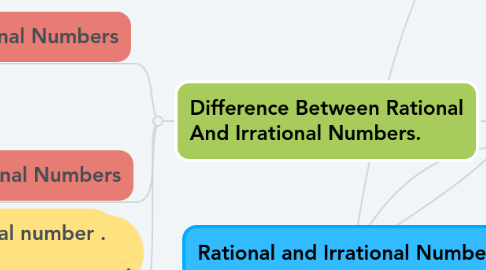Rational and Irrational Numbers
par Joemae Mahinay

1. Irrational Number
1.1. Irrational numbers have endless non-repeating digits after the decimal point.
1.2. Examples of Irrational Numbers 1.) 5/0 is an irrational number, with the Denominator as zero. 2.) pie is an irrational number which has Value 3.142... and is a never ending and non-repeating number. 3.) √2 is an irrational number, as it cannot be simplified . 4.) 0.212112111... is a rational number as it is non- recurring and non- terminating.
2. Difference Between Rational And Irrational Numbers.
2.1. Rational Numbers
2.1.1. •It is impossible to express irrational numbers as fractions or in a ratio of two integers. • It includes surds •Here, non-terminating and non-recurring decimals are executed.
2.1.2. °It is expressed in ratio, where both numerator and denominator are the whole numbers. ° It includes perfect squares °The decimal expansion for rational number executes finite or recurring decimals.
2.2. Irrational Numbers
2.3. The numbers which are not a rational number are called irrational number . It could be written in decimals but not in the form of fractions, which means it cannot be written as the ratio of two integers.
3. Rational Number
3.1. Rational numbers are numbers which can be expressed as a fraction and also as positive and negative numbers and zero.
3.2. The word rational is derived from the word ratio, which actually means a comparison of two or more values or integer number and is known as a fraction.
3.3. Examples of Rational Numbers 1. ) Number 9 can be written as 9/1 where 9 and 1 both are integers. 2.) 0.5 can be written as 1/2,5/10 or 10/20 and In the form of all termination decimals. 3.) √81 is a rational number, as it can be Simplified to 9 and can be expressed as 9/1. 4.) 0.7777777 is recurring decimals and is a rational number.
4. Rational and Irrational Numbers both are real number but different with respect to their properties.
5. Properties of Rational and Irrational Numbers
5.1. Here are some rules based on arithmetic operations such as Addition and multiplication performed on the rational number and irrational number.
5.2. Rule #1. The sum of two rational number is also rational. Example: 1/2 + 1/3 = (3+2)/6 = 5/6
5.3. Rule #2. The product of two rational number is rational. Example: 1/2 x 1/3 = 1/6
5.4. Rule #3. The sum of two irrational number is not always irrational. Example: √2 + √2 = 2√2 is rational 2 + 2√5 +(-2√5) = 2 is rational
5.5. Rule #4. The product of two irrational numbers is not always irrational. Example: √2 x √3 = √6 (irrational) √2 x √2 =√4 = 2 (rational)


